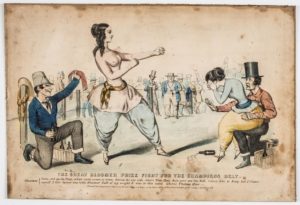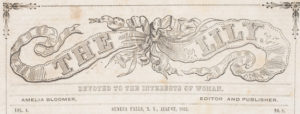The second in a two-part series, this blog post features an AAS-based undergraduate project, “Queering the Archive” at College of the Holy Cross. Under the advisement of Professor Stephanie Yuhl of the History Department, Carly Priest ‘18 and Emily Breakell ‘17 spent the summer searching for resources relevant to the history of transgender and gender-nonconforming people in the United States. Please find their first post here.
During our search for transgender-related materials in the archives of the American Antiquarian Society, we came across over 140 pieces that depicted cross-dressing in public. Unsurprisingly, the reception to cross-dressing in the nineteenth-century records we identified appeared overwhelmingly negative. Time and time again, we encountered police reports that equated cross-dressing with sexual deviance and spectacle, and sensationalist newspaper accounts that berated individuals for their aberrance from gender norms.
We found many of the sources that featured depictions of cross-dressing expressed social anxieties over the shifting role of white women in society. The voices of these concerns often characterized women who “masqueraded as the other sex”— who bent traditional gender norms through dress—as attempts to transcend gender roles, part and parcel of the fundamental threat facing the patriarchal structure of the emerging American democracy. One lithograph in particular, The Great Bloomer Prize Fight for the Champions Belt (1851), shed new light on some of these negative public reactions.

The focal point of the lithograph is a caricature of Amelia Bloomer, social activist for women’s rights, editor of The Lily— the first periodical published for women, by women—and fashion icon. For all her roles in American political culture, many recall Bloomer for her contribution to female apparel: bloomer trousers.

Bloomer trousers were loose-fitted pantaloons often paired with an overdress, worn by women and children. While many praised bloomers only as a less-constrictive clothing alternative for women, others embraced the bloomer-trouser style as a symbol of the literal movement for female mobility and equality in the public sphere. The Lily cited bloomers a political issue “too intimately connected with the elevation of women to be neglected.”[1]
The Lily, and other publications like it, were not without criticism. Many opposed bloomers as the vehicle for disruption to established social order. In this line of argument, women who wore bloomers did so to appear male and acquire the power naturally held by men in society. “Her Bicycle Clothes Didn’t Suit” (The Illustrated Police News, 1898) follows such narrative— the article detailed the story of Maggie White, who wore “men’s clothing in too extreme a style to suit the critical eye of the police” and was arrested for it. According to the apprehending officer, Sergeant Connealy, “[White’s] black coat was cut like a man’s; but the things she wore on her legs were too tight for the taste of any man.”[2] Connealy acted on his suspicions, and followed White for several blocks before arresting her on New York City’s Sixty-eighth street. The charge? Disorderly conduct. White donned pantaloons— likely bloomers—that closely resembled knickers (short pants worn by men).
Though published thirty years’ prior, The Great Bloomer Prize Fight for the Champions Belt reflects concerns similar to those expressed in “Her Bicycle Clothes Didn’t Suit.” The piece features a larger-than-life Bloomer engaged in a bare-knuckle boxing match, dressed in the pants that came to bear her name. A crying woman (also appareled in bloomers) frames Bloomer to her right, and sits on the knee of a male figure. On Bloomer’s left, a second kneeling man holds a bottle of alcohol in one hand and offers Bloomer the “Champions Belt” with his other.
In the piece, bloomers offer a visual clue to the absurdity of a woman who wants to act as a man. Though Bloomer shares the frame with three others, including two men, she towers over them, her body disproportionately large. Bizarrely, Bloomer appears both masculinized and hyper-feminized all at once— though with long limbs and macho stance, the artist depicts Bloomer with perfectly coiffed and curled hair. She wears a tight white shirt, her features clearly defined and her breasts emphasized.
The caption of The Great Bloomer Prize Fight for the Champions Belt offers a further critique of cross-dressing in society. Bloomer flaunts victory in the caption, and requests another challenger— specifically, Tom “Young America” Hyer. Hyer, a famous bare-knuckle boxer, beat the Irish-born James Sullivan in 1849 (two years prior to circulation of this lithograph). Though bare-knuckle boxing was illegal, the widely-publicized fight was one of the first organized boxing championship bouts in the United States.
The threat of disorder to society is the core theme of this lithograph— the two women in bloomers and the alcohol bottles held by the men make for a clear and deferential critique of low society. But, perhaps more compellingly, we see the suggestion that Bloomer is trying to become a man by participating in bare-knuckle boxing— an illegal sport in a distinctively male sphere. With her nipples exposed, Bloomer resembles male boxers— like Hyer and Sullivan—but her appearance becomes offset by the exaggerated femininity of her breasts and hair.[3] The intended effect of this portrayal— a larger-than-life woman who towers over the men frame— is a clownish figure, one which resembles both a man and a woman.
The Great Bloomer Prize Fight for the Champions Belt reaches further than just an aversion to cross-dressing. In the piece, we see the suggestion that Bloomer’s gender boundary transgression— wearing bloomers—bends gender norms in a way emblematic of a greater deterioration to American society. Bloomer suggests a corruption of American society. The creator of The Great Bloomer Prize Fight for the Champions Belt relied on the symbolic threats of amalgamation—alcohol-fueled fights and boxing as corruptive low-society influences to American sensibilities— to illustrate the danger of a woman who dressesand acts like a man. With this understanding, we may begin re-consider The Great Bloomer Prize Fight for the Champions Belt as more than just a critique of bloomers.
[1] THOMAS, MARY F. “DRESS REFORM.” Lily: Devoted To The Interest Of Women 4, no. 8 (August 1852): 70-71. American Antiquarian Society (AAS) Historical Periodicals Collection: Series 3, EBSCOhost (accessed July 25, 2017) and “LATEST FASHION.” Lily: Devoted To The Interest Of Women 4, no. 8 (August 1852): 71. American Antiquarian Society (AAS) Historical Periodicals Collection: Series 3, EBSCOhost (accessed July 25, 2017).
[2] “Her Bicycle Clothes Didn’t Suit.” Criminal Columns section of the Illustrated Police News, 16 July 1898, p. 6. Crime, Punishment, and Popular Culture 1790-1920, tinyurl.galegroup.com/tinyurl/4xQra0. Accessed 11 July. 2017.
[3] “The Great Fight.” From Underbelly, The Maryland Historical Society Library. March 27, 2014, accessed 27 July 2017. http://www.mdhs.org/underbelly/2014/03/27/the-great-fight/.
